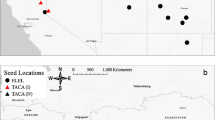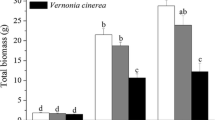Abstract
Increased or fluctuating resources may facilitate opportunities for invasive exotic plants to dominate. This hypothesis does not, however, explain how invasive species succeed in regions characterized by low resource conditions or how these species persist in the lulls between high resource periods. We compare the growth of three co-occurring C4 perennial bunchgrasses under low resource conditions: an exotic grass, Eragrostis curvula (African lovegrass) and two native grasses, Themeda triandra and Eragrostis sororia. We grew each species over 12 weeks under low nutrients and three low water regimes differentiated by timing: continuous, pulsed, and mixed treatments (switched from continuous to pulsed and back to continuous). Over time, we measured germination rates, time to germination (first and second generations), height, root biomass, vegetative biomass, and reproductive biomass. Contrary to our expectations that the pulsed watering regime would favor the invader, water-supply treatments had little significant effect on plant growth. We did find inherent advantages in a suite of early colonization traits that likely favor African lovegrass over the natives including faster germination speed, earlier flowering times, faster growth rates and from 2 weeks onward it was taller. African lovegrass also showed similar growth allocation strategies to the native grasses in terms of biomass levels belowground, but produced more vegetative biomass than kangaroo grass. Overall our results suggest that even under low resource conditions invasive plant species like African lovegrass can grow similarly to native grasses, and for some key colonization traits, like germination rate, perform better than natives.





Similar content being viewed by others
References
Baker HG (1964) Characteristics and modes of origin of weeds. In: Baker HG, Ledyard Stebbins G (eds) The genetics of colonizing species. Academic Press Inc., New York, pp 147–172
Chapin FS III, Autumn K, Pugnaire F (1993) Evolution of suites of traits in response to environmental stress. Am Nat 142(S1):S78–S92. doi:10.1086/285524
Chesson P, Gebauer RLE, Schwinning S, Huntly N, Wiegand K, Ernest MSK, Sher A, Novoplansky A, Weltzin JF (2004) Resource pulses, species interactions, and diversity maintenance in arid and semi-arid environments. Oecologia 141(2):236–253. doi:10.1007/s00442-004-1551-1
Cole BI, Lunt ID (2005) Restoring Kangaroo Grass (Themeda triandra) to grassland and woodland understoreys: a review of establishment requirements and restoration exercises in south-east Australia. Ecol Manag Restor 6(1):28–33. doi:10.1111/j.1442-8903.2005.00216.x
Colom MR, Vazzana C (2003) Photosynthesis and PSII functionality of drought-resistant and drought-sensitive weeping lovegrass plants. Environ Exp Bot 49(2):135–144. doi:10.1016/s0098-8472(02)00065-5
Crawley MJ (2005) Statistics: an introduction using R. vol Book, Whole. Wiley, Chichester
Daehler CC (2003) Performance comparisons of co-occurring native and alien invasive plants: implications for conservation and restoration. Annu Rev Ecol Evol Syst 34(1):183–211. doi:10.1146/annurev.ecolsys.34.011802.132403
D’Antonio CM, Vitousek PM (1992) Biological invasions by exotic grasses, the grass/fire cycle, and global change. Annu Rev Ecol Syst 23(1):63–87. doi:10.1146/annurev.es.23.110192.000431
Davis MA, Grime JP, Thompson K (2000) Fluctuating resources in plant communities: a general theory of invisibility. J Ecol 88(3):528–534. doi:10.1046/j.1365-2745.2000.00473.x
Drenovsky RE, Martin CE, Falasco MR, James JJ (2008) Variation in resource acquisition and utilization traits between native and invasive perennial forbs. Am J Bot 95(6):681–687. doi:10.3732/ajb.2007408
Fenesi A, Botta-Dukat Z (2010) Do short-lived and long-lived alien plant species differ regarding the traits associated with their success in the introduced range? Biol Invasions 12(3):611–623. doi:10.1007/s10530-009-9468-6
Firn J (2009) African lovegrass in Australia: a valuable pasture species or embarrassing invader? Trop Grassl 43:86–97
Firn J, House APN, Buckley YM (2010a) Alternative states models provide an effective framework for invasive species control and restoration of native communities. J Appl Ecol 47(1):96–105. doi:10.1111/j.1365-2664.2009.01741.x
Firn J, MacDougall A, Schmidt S, Buckley YM (2010b) Early emergence and resource availability can competitively favour natives over a functionally similar invader. Oecologia 163(3):775–784. doi:10.1007/s00442-010-1583-7
Franks SJ, Sim S, Weis AE (2007) Rapid evolution of flowering time by an annual plant in response to a climate fluctuation. Proc Nat Acad Sci USA 104(4):1278–1282. doi:10.1073/pnas.0608379104
Funk JL (2008) Differences in plasticity between invasive and native plants from a low resource environment. J Ecol 96(6):1162–1173. doi:10.1111/j.1365-2745.2008.01435.x
Funk JL, Vitousek PM (2007) Resource-use efficiency and plant invasion in low-resource systems. Nature 446(7139):1079–1081. doi:10.1038/nature05719
Funk J, Zachary V (2010) Physiological responses to short-term water and light stress in native and invasive plant species in southern California. Biol Invasions 12(6):1685–1694. doi:10.1007/s10530-009-9581-6
Galloway LF, Etterson JR (2007) Transgenerational plasticity is adaptive in the wild. Science 318(5853):1134–1136. doi:10.1126/science.1148766
Grime JP (1977) Evidence for the existence of three primary strategies in plants and its relevance to ecological and evolutionary theory. Am Nat 111(982):1169–1194. doi:10.1086/283244
Hagon M, Chan C (1977) The effects of moisture stress on the germination of some Australian native grass seeds. Aust J Exp Agric 17(84):86–89. doi:10.1071/EA9770086
Ho MD, Rosas JC, Brown KM, Lynch JP (2005) Root architectural tradeoffs for water and phosphorus acquisition. Funct Plant Biol 32(8):737–748. doi:10.1071/FP05043
MacDougall AS, Turkington R (2005) Are invasive species the drivers or passengers of change in degraded ecosystems? Ecology 86(1):42–55. doi:10.1890/04-0669
Mack MC, D’Antonio CM (1998) Impacts of biological invasions on disturbance regimes. Trends Ecol Evol 13(5):195–198. doi:10.1016/S0169-5347(97)01286-X
Maestre FT, Reynolds JF (2007) Amount or pattern? Grassland responses to the heterogeneity and availability of two key resources. Ecology 88(2):501–511. doi:10.1890/06-0421
Mangla S, Sheley RL, James JJ, Radosevich SR (2011) Intra and interspecific competition among invasive and native species during early stages of plant growth. Plant Ecol 212(4):531–542. doi:10.1007/s11258-011-9909-z
Maze K, Koen T, Watt L (1993) Factors influencing the germination of six perennial grasses of central New South Wales. Aust J Bot 41(1):79–90. doi:10.1071/BT9930079
Mitchell CE, Agrawal AA, Bever JD, Gilbert GS, Hufbauer RA, Klironomos JN, Maron JL, Morris WF, Parker IM, Power AG, Seabloom EW, Torchin ME, Vázquez DP (2006) Biotic interactions and plant invasions. Ecol Lett 9(6):726–740. doi:10.1111/j.1461-0248.2006.00908.x
Moore JE, Lacey EP (2009) A comparison of germination and early growth of four early successional tree species of the southeastern United States in different soil and water regimes. Am Midl Nat 162(2):388–394. doi:10.1674/0003-0031-162.2.388
Nicotra AB, Davidson A (2010) Adaptive phenotypic plasticity and plant water use. Funct Plant Biol 37(2):117–127. doi:10.1071/fp09139
Novoplansky A, Goldberg DE (2001) Effects of water pulsing on individual performance and competitive hierarchies in plants. J Veg Sci 12(2):199–208. doi:10.2307/3236604
Padilla F, Miranda J, Jorquera M, Pugnaire F (2009) Variability in amount and frequency of water supply affects roots but not growth of arid shrubs. Plant Ecol 204(2):261–270. doi:10.1007/s11258-009-9589-0
Prober SM, Thiele KR, Lunt ID, Koen TB (2005) Restoring ecological function in temperate grassy woodlands: manipulating soil nutrients, exotic annuals and native perennial grasses through carbon supplements and spring burns. J Appl Ecol 42(6):1073–1085. doi:10.1111/j.1365-2664.2005.01095.x
Pyšek P, Richardson DM (2007) Traits associated with invasiveness in alien plants: where do we stand? In: Nentwig W (ed) Biological invasions, vol 193. Ecological studies. Springer, Berlin, Heidelberg, pp 97–125. doi:10.1007/978-3-540-36920-2_7
R Development Core Team (2011) R: A language and environment for statistical computing. R Foundation for Statistical Computing, Vienna
Rejmánek M (1996) A theory of seed plant invasiveness: the first sketch. Biol Conserv 78(1):171–181. doi:10.1016/0006-3207(96)00026-2
Rout ME, Callaway RM (2009) An invasive plant paradox. Science 324(5928):734–735. doi:10.1126/science.1173651
Sakai AK, Allendorf FW, Holt JS, Lodge DM, Molofsky J, With KA, Baughman S, Cabin RJ, Cohen JE, Ellstrand NC, McCauley DE, O’Neil P, Parker IM, Thompson JN, Weller SG (2001) The population biology of invasive species. Annu Rev Ecol Syst 32:305–332. doi:10.1146/annurev.ecolsys.32.081501.114037
Sax DF, Brown JH (2000) The paradox of invasion. Glob Ecol Biogeogr 9(5):363–371. doi:10.1046/j.1365-2699.2000.00217.x
Seabloom EW, Harpole WS, Reichman OJ, Tilman D (2003) Invasion, competitive dominance, and resource use by exotic and native California grassland species. Proc Nat Acad Sci USA 100(23):13384–13389. doi:10.1073/pnas.1835728100
Shea K, Chesson P (2002) Community ecology theory as a framework for biological invasions. Trends Ecol Evol 17(4):170–176. doi:10.1016/S0169-5347(02)02495-3
Terry Therneau and original Splus-> R port by Thomas Lumley (2011) Survival: survival analysis, including penalised likelihood
Werner C, Zumkier U, Beyschlag W, Maguas C (2010) High competitiveness of a resource demanding invasive acacia under low resource supply. Plant Ecol 206(1):83–96. doi:10.1007/s11258-009-9625-0
Whitney KD, Gabler CA (2008) Rapid evolution in introduced species, ‘invasive traits’ and recipient communities: challenges for predicting invasive potential. Divers Distrib 14(4):569–580. doi:10.1111/j.1472-4642.2008.00473.x
Wright IJ, Reich PB, Cornelissen JHC, Falster DS, Garnier E, Hikosaka K, Lamont BB, Lee W, Oleksyn J, Osada N, Poorter H, Villar R, Warton DI, Westoby M (2005) Assessing the generality of global leaf trait relationships. New Phytol 166(2):485–496. doi:10.1111/j.1469-8137.2005.01349.x
Acknowledgments
We thank Katrina Cousins for assisting the glasshouse experiment and Kenneth Hayes and Nicole Robinson for their additional assistance and loan of equipment. Thank you to CSIRO Ecosystem Sciences and Australian Research Council (YB, DP0771387) for funding.
Author information
Authors and Affiliations
Corresponding author
Electronic supplementary material
Below is the link to the electronic supplementary material.
Rights and permissions
About this article
Cite this article
Han, Y., Buckley, Y.M. & Firn, J. An invasive grass shows colonization advantages over native grasses under conditions of low resource availability. Plant Ecol 213, 1117–1130 (2012). https://doi.org/10.1007/s11258-012-0070-0
Received:
Accepted:
Published:
Issue Date:
DOI: https://doi.org/10.1007/s11258-012-0070-0




